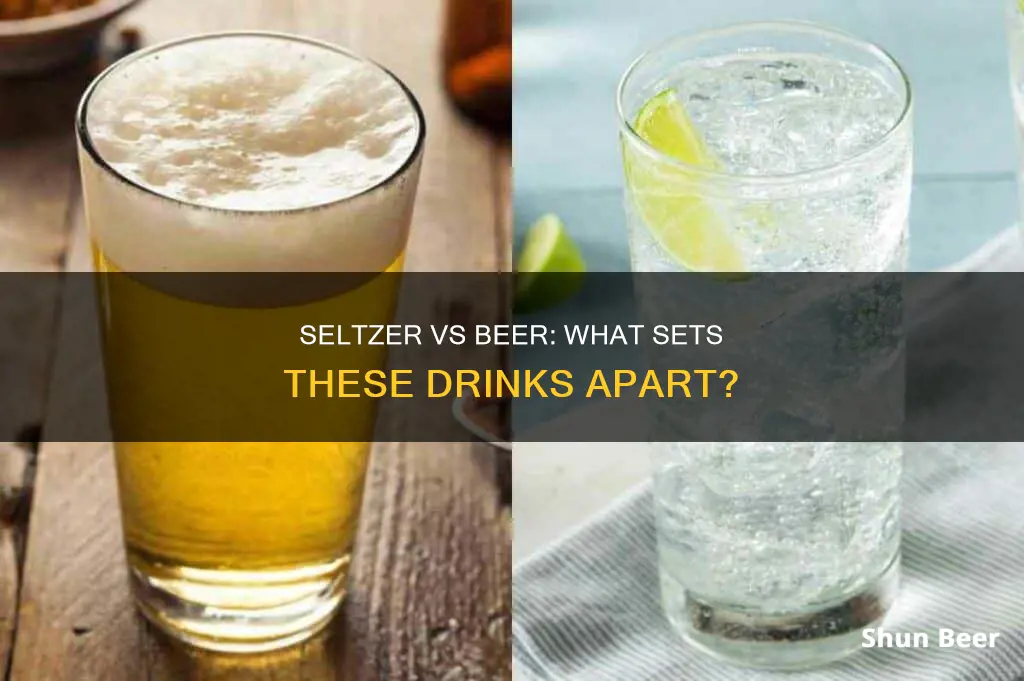
Hard seltzer and beer are both alcoholic beverages that are produced through fermentation. However, the key difference lies in the fermentation process and the ingredients used. Beer is made by mashing malted grains in hot water to extract sugars and create a wort, which is then boiled, cooled, and combined with hops and yeast to turn it into alcohol. On the other hand, hard seltzer is typically made by fermenting cane sugar or malted barley in water, resulting in a clear alcohol that is carbonated and often infused with fruit flavors. This difference in production gives hard seltzer its clear appearance and allows for more control over calories and carbs, making it a popular choice for health-conscious consumers.
What You'll Learn
- Beer is made from malted grains, while hard seltzer is made from fermented cane sugar
- Beer has a wide range of colours, hard seltzer is clear
- Beer has more calories than hard seltzer
- Hard seltzer is gender-neutral, beer is marketed as 'manly'
- Hard seltzer is a relatively new drink, beer has been around for centuries

Beer is made from malted grains, while hard seltzer is made from fermented cane sugar
Beer and hard seltzer are similar in many ways. Both are brewed and fermented, using a sugar source to create a sweet liquid that, with yeast, turns into alcohol. However, the key difference is what is fermented.
Beer
Beer is made from malted grains, most commonly malted barley, although wheat, maize (corn), rice, and oats are also used. The malted grains are mashed in hot water to extract the sugars from the grains to make a wort. The wort is then boiled and cooled, and hops are added. When the wort is cooled, yeast is added, turning the sugary mixture into alcohol.
Hard Seltzer
Hard seltzer, on the other hand, is typically made from fermented cane sugar in water. While grains can be used, brewers usually skip this process and go straight to fermenting the sugar. The result is a clear alcohol that is carbonated after fermentation. The use of sugar and water creates a blank canvas that allows for the addition of fruit flavorings, while giving the brewer additional control to keep calories and carbs low.
In summary, beer is made from malted grains, while hard seltzer is made from fermented cane sugar. This difference in ingredients and fermentation processes results in two distinct alcoholic beverages with unique characteristics and appeal to different consumer preferences.
Pilsner vs Lager Beer: What's the Difference?
You may want to see also

Beer has a wide range of colours, hard seltzer is clear
Beer and hard seltzer are produced in similar ways. Both are brewed and fermented, using a sugar source to create a sweet liquid that, with yeast, turns into alcohol. However, the key difference is what is fermented. Beer gets its distinct colours from the grains and other ingredients used in the brewing process. In beer’s case, malted grains are mashed in hot water to extract the sugars from the grains to make a wort. The wort is then boiled and cooled, and hops are added during these stages. When the wort is cooled and yeast is added, it turns the sugary mixture into alcohol. Beer thus receives its colour from the grains used in the process.
On the other hand, hard seltzer starts out clear, using nothing but sugar and water. The sugar is fermented in water, and the result is clear alcohol that’s carbonated post-fermentation. This is the point where real fruit juice is added, giving the drink its distinct colour. This process allows brewers to add whatever fruit juice and flavours they want, while also controlling carbs and maintaining a lower calorie count.
The blank canvas of hard seltzer allows for the addition of fruit flavourings, while beer's colour comes from the grains and other ingredients used in the brewing process.
Beer Carbonation: Why the Fizz Differs
You may want to see also

Beer has more calories than hard seltzer
Hard seltzer is made with brewed cane sugar and/or malted rice, with soda water and flavourings added. It's a clear, carbonated alcohol that's similar to beer in terms of alcohol content, which is typically around 5% for both. However, the use of fermented sugars in hard seltzer, rather than fermented grains, means it's usually gluten-free.
The lower calorie content of hard seltzer is one of its main selling points. It's often marketed as a healthier alternative to beer and other alcoholic drinks, and its rise in popularity is partly attributed to increased demand from health-conscious consumers. However, it's important to note that low-calorie doesn't always mean healthier, and overconsumption of hard seltzer can still lead to negative health effects due to its alcohol content.
In addition to its calorie content, hard seltzer also tends to have fewer carbohydrates than beer. A 12-ounce can of hard seltzer typically has around 2 grams of carbohydrates, while beer has between 10 and 15 grams. This makes hard seltzer a good option for those following a keto or low-carb diet.
Stout vs Porter: Unveiling Beer's Dark Secrets
You may want to see also

Hard seltzer is gender-neutral, beer is marketed as 'manly'
Hard seltzer is a type of highball drink containing carbonated water, alcohol, and often fruit flavourings. The alcohol content is typically around 5%, and the calorie content is relatively low. Hard seltzer brands have been careful to avoid gender bias in their marketing, which has contributed to their popularity. These brands have gender-neutral advertising to reach as many people as possible, and their social media presence often depicts healthy people drinking and having fun. This is in contrast to beer, which has often been advertised as being 'manly', with darker beers like porters, ales, and stouts being considered 'manly' by some. However, it's important to note that the notion of a 'manly' beer is an arbitrary social distinction, and anyone can drink whatever they please.
The gender-neutral marketing of hard seltzer brands has been a deliberate strategy to appeal to a wider range of consumers. For example, the popular hard seltzer brand White Claw uses a neutral white and grey logo of a wave on its cans, which is considered 'masculine' enough to appeal to men who are conscious of their calorie intake. In contrast, beer has often been marketed towards men, with some brands and beer styles being perceived as more manly than others. This gendered marketing approach has been criticised by some, who argue that alcoholic beverage ads should not be targeted towards specific genders.
The early innovators of hard seltzer avoided gender bias in their marketing, recognising that the appeal of a healthier, more approachable beverage is universal. By steering clear of traditional marketing tactics that might have promoted the bubbly, fruity flavours to women exclusively, brands like Truly and White Claw have achieved success across a diverse range of consumers. This inclusive approach to marketing has paid off, with data showing that hard seltzer is not favoured by one gender over the other. The strategy of smashing gender norms and creating something fresh and unique has been praised by marketing experts.
The gender-neutral marketing of hard seltzer has contributed to its surge in popularity, especially among health-conscious consumers. The low-calorie, low-sugar nature of hard seltzer appeals to those seeking healthier alternatives to more calorific alcoholic beverages. By positioning themselves as a healthy option, hard seltzer brands have attracted consumers who might otherwise have chosen beer or other sugary cocktails. This shift towards gender-neutral marketing and health-conscious consumers represents a broader change in the alcoholic beverage industry, with hard seltzer leading the way.
German Beer Imports: Different or Just Marketing?
You may want to see also

Hard seltzer is a relatively new drink, beer has been around for centuries
Hard seltzer is a relatively new drink that has taken the world by storm, while beer has been a popular beverage for centuries. The first hard seltzer was introduced in 2013 by a brand called 'Spiked Seltzer'. Beer, on the other hand, has a long history that dates back to ancient times, with evidence of beer consumption found in ancient Sumerian texts and Egyptian tomb paintings.
The main difference between hard seltzer and beer lies in the fermentation process and the resulting flavour, colour, and nutritional content. Hard seltzer is typically made by fermenting cane sugar or other sugar sources with water, resulting in a clear, colourless, and flavourless alcohol base. Brewers then add fruit flavours to this blank canvas, creating a variety of fruity options such as raspberry, mango, and lemon. The addition of real fruit juice gives some hard seltzers their distinct colour.
In contrast, beer is made by fermenting malted grains, such as barley or wheat, which are mashed into hot water to extract the sugars. The resulting substance, known as wort, is boiled, cooled, and then fermented with yeast to turn the sugars into alcohol. The grains used in the brewing process give beer its wide range of colours, from pale to very dark, and contribute to its unique taste, which can be bitter, sweet, or have a bread-like, lingering sweetness.
Hard seltzer is often marketed as a healthier alternative to beer due to its lower calorie and carbohydrate content. A standard 12-ounce can of hard seltzer typically contains around 100 calories and 2 grams of carbohydrates, while a similar serving of beer contains 150-200 calories and 15-30 grams of carbohydrates. The higher fluid content in hard seltzer, due to its large percentage of carbonated water, also contributes to better hydration when compared to beer.
In terms of alcohol content, hard seltzer and beer can have similar levels. Both typically have an average alcohol content of around 5% ABV, although light beers can have as low as 4% ABV, and certain strong ales can reach up to 12% ABV.
While hard seltzer is a recent addition to the beverage market, beer has had a much longer history and cultural significance. Beer has been a drink of choice for many occasions, from sports events to casual get-togethers and barbecues. Hard seltzer, on the other hand, has become popular for more relaxed, sun-soaked gatherings like pool parties and beach outings, offering a light and refreshing taste in convenient, portable cans.
IPA Beer: Unique Effects and Experiences
You may want to see also
Frequently asked questions
The main difference is what is being fermented. In beer, malted grains are mashed in hot water to extract sugars and make wort, which is then boiled and cooled with added hops. In the case of hard seltzer, grains can be used but brewers usually skip this process and go straight to fermenting straight-up sugar or cane sugar in water.
Beer gets its colour from the grains and other ingredients used in the brewing process. Hard seltzer starts out clear, which means brewers can add whatever fruit juice and flavours they want. It also allows them to control carbs and maintain a lower calorie count.
The alcohol content of most spiked seltzers falls in the range of 4-6% alcohol by volume (ABV) — about the same as light beer — although some can be as high as 12% ABV. Light beers are typically around 3-5% ABV and craft beers can be upwards of 7-10% ABV.
Hard seltzer is often marketed as a healthier alternative to beer because it is gluten-free, low-calorie, low-sugar, low-carb, and low-alcohol. However, it is important to note that hard seltzer is not a healthy drink and nutritionists have warned that it is not as healthy as it is often portrayed.







